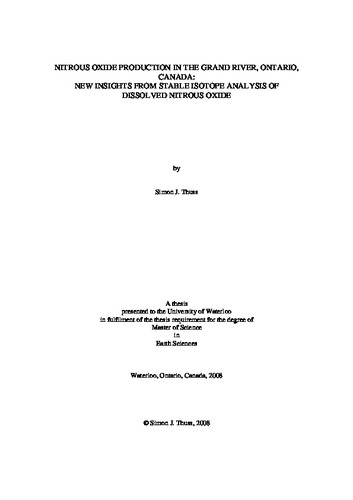| dc.description.abstract | Nitrous oxide (N₂O) is a powerful greenhouse gas, and its atmospheric concentration is increasing dramatically. N₂O is produced through the microbially-mediated processes of nitrification and denitrification. Since these processes have different substrates and isotopic enrichment factors, stable isotope analysis (δ¹⁵N and δ¹⁸O) of N₂O can be used to study the production of this important greenhouse gas.
Although production in rivers accounts for a significant portion of the global N₂O budget, the isotopic composition of N₂O from this source is poorly characterized. Most of the previous work using stable isotopes of N₂O has been conducted in terrestrial or oceanic environments, and only one published study has measured δ¹⁵N and δ¹⁸O of N₂O produced in a riverine environment. The purpose of this research project was to use stable isotope analysis to characterize the processes responsible for N₂O production in the Grand River, Ontario, Canada, and to determine the spatial and temporal variability of the isotopic composition of the N₂O flux.
To meet the study objectives, an offline “purge and trap” method was developed to collect and purify dissolved N₂O for stable isotope analysis. Using this method, δ¹⁵N and δ¹⁸O analysis of dissolved N₂O is possible for samples with concentrations as low as 6 nmol N₂O/L.
Due to the isotopic effects of gas exchange and the back flux of tropospheric N₂O, there is a complex relationship between the δ¹⁵N and the δ¹⁸O of source, dissolved, and emitted N₂O in aquatic environments. A simple box model (SIDNO – Stable Isotopes of Dissolved Nitrous Oxide) was developed to properly interpret isotopic data for dissolved N₂O. Using this model, it was determined that the isotopic composition of emitted N₂O is much more representative of N₂O production in aquatic environments than the isotopic composition of dissolved N₂O. If the concentration, δ¹⁵N and δ¹⁸O of dissolved N₂O are measured, the magnitude and isotopic composition of the N₂O flux can be calculated.
Sampling downstream of the major wastewater treatment plants (WWTPs) on the Grand River indicates that nitrification and denitrification in the river are strongly tied to diel changes in dissolved oxygen (DO) concentration. During the day, when DO concentrations are high, nitrification or nitrifier-denitrification is the dominant N₂O production pathway, with sediment denitrification also contributing to N₂O production. At night, when DO concentrations are low, denitrification in the sediments and at the sediment / water interface is the dominant production pathway. Using the SIDNO model, N₂O produced during the day was found to have a δ¹⁵N of -22‰ and a δ¹⁸O of 43‰. N₂O produced at night had a δ¹⁵N of -30‰ and a δ¹⁸O of 30‰. The isotopic composition of N₂O emitted from the Grand River is dominated by night-time production downstream of the Waterloo and Kitchener WWTPs during the summer. The flux and time weighted annual average isotopic composition of N₂O emitted from the Grand River is -18.5‰ and 32.7‰ for δ¹⁵N and δ¹⁸O respectively. These values are significantly more depleted than the only other published data for riverine N₂O production. If the Grand River is representative of global riverine N₂O production, these results will have significant implications for the global isotopic budget for atmospheric N₂O. | en |

